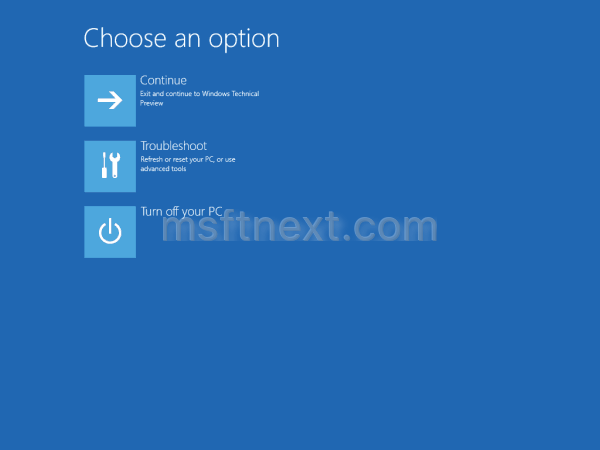Enable Windows 10 Recovery Environment
- Manually Enable Windows Recovery Environ…
- Enable Windows 10 Recovery Environment Not Found
- Winre In Windows 10
Hello!
In Windows 10, the Windows Recovery Environment has become a very sophisticated, almost eerily intelligent fix-everything program that works very well. Except, of course, when it doesn’t. You know you’re in the Windows Recovery Environment if you see a blue Choose an Option screen or a blue Troubleshoot screen like the one shown here. Jul 16, 2019 How to Enable or Disable Windows Recovery Environment (WinRE) in Windows 10 Windows Recovery Environment (WinRE) is a recovery environment that can repair common causes of unbootable operating systems. By default, WinRE is preloaded into the Windows 10 for desktop editions (Home, Pro, Enterprise, and Education) and Windows Server 2016 installations. Nov 09, 2015 Unable to enable BitLocker after clean install of Windows 10 After Windows 10 Release. Ask your administrator to configure Windows Recovery Environment so that you can use BitLocker. I checked the forums on how to enable the Windows Recovery Environment. The ReAgent file found in the Recovery Media's.wim file does not have values for the.
After upgrading my Surface Pro 3 to Windows 10, I created a recovery disk to be able to clean install Windows 10.
Rebooting from the Recovery Disk, the following happened:
1. BitLocker was disabled
2. TPM clear prompt showed and clicked Yes to continue
3. Normal set-up (just like in my other laptops I had a clean install of Windows 10)
Now, I have the Windows 10 set-up. I am trying to enable BitLocker again. But I get the following message:
This PC deosn't support entering a BitLocker recovery password during startup. Ask your administrator to configure Windows Recovery Environment so that you can use BitLocker.
I checked the forums on how to enable the Windows Recovery Environment. The ReAgent file found in the Recovery Media's .wim file does not have values for the WinRELocation path but it does not have any zero GUIDs too. The ReAgent file found in the System32 of my computer, have zero GUIDs but no values on the paths.
I tried to enable using Reagentc /enable and I get an error of Windows RE image not found.
Thanks for the help!
In Windows 10, the Windows Recovery Environment has become a very sophisticated, almost eerily intelligent fix-everything program that works very well. Except, of course, when it doesn’t.
You know you’re in the Windows Recovery Environment if you see a blue Choose an Option screen or a blue Troubleshoot screen like the one shown here. (If you find yourself facing a blue Choose an Option screen, choose Troubleshoot!)
From the Troubleshoot screen, you can run Refresh or Reset directly: You can also choose Advanced Options, which brings you to several interesting — if little-used — options, as shown here.
You can also get to this screen by choosing Advanced Startup from the Recovery list. After you choose Advanced Startup, choose Troubleshoot and then choose Advanced Options.
Naruto Shippuden 2: The Akatsuki Makes Its Move. Naruto Shippuden. Episode 1: Homecoming Subtitled. Dubbed Subtitled. A figure passes through the gates. It's an older Naruto, who has returned from a long training journey with Jiraiya. Naruto Uzumaki is back! Naruto shippuden episode 1.
Manually Enable Windows Recovery Environ…
Here’s what the Advanced Options can do:
Enable Windows 10 Recovery Environment Not Found

Winre In Windows 10
System Restore puts your system back to a chosen restore point. It won’t work, though, unless you’ve turned on System protection/restore points for one or more drives on your computer.
System Image Recovery requires a system image file that you can make only by using the DOS command line in a very geeky way. The particular command you need is recimg.exe. Details at the Windows 10 forums.
Startup Repair reboots into a specific Windows Recovery Environment program known as Start Repair and runs a diagnosis and repair routine that seeks to make your PC bootable again. A Start Repair log file is generated at WindowsSystem32LogfilesSrtSrtTrail.txt. If you find yourself running Automatic Repair, you can’t do anything: Just hold on and see whether it works.
Command Prompt brings up an old-fashioned DOS command prompt, just like you get if you go into Safe Mode. Only for the geek at heart. You can hurt yourself in there.
Startup Settings reboots Windows and lets you go into Safe Mode, change video resolution, start debugging mode or boot logging, run in Safe Mode, disable driver signature checks, disable early launch anti-malware scans, and disable automatic restart on system failure. Definitely not for the faint of heart.
If you ever wondered how to do an old-fashioned “F8” boot into Safe Mode, now you know.